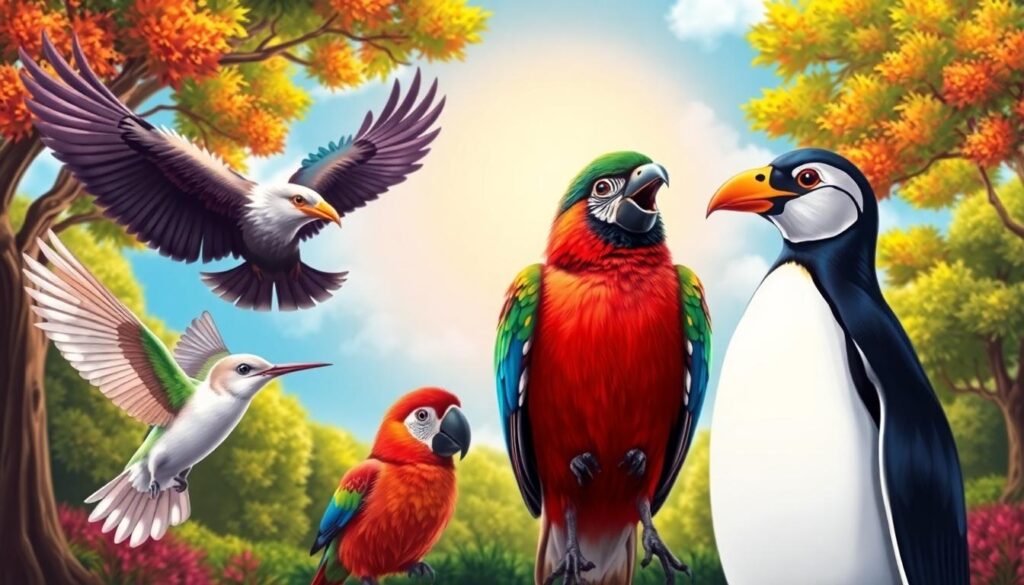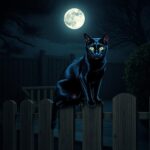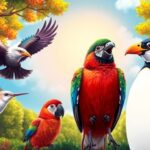Birds have fascinated humans for centuries with their ability to soar through skies, their colorful plumage, and their melodious songs. What better way to celebrate these wonderful creatures than through the timeless art of riddles? Bird riddles not only entertain but also help us learn about our feathered friends in a fun and captivating way.
We’ve gathered an exceptional collection of bird-themed brain teasers that will challenge both young minds and seasoned puzzle enthusiasts alike. From simple riddles perfect for children to more complex ones that will make adults scratch their heads, there’s something here for everyone. These riddles are perfect for family game nights, classroom activities, or just to test your ornithological knowledge.
10 Brain-Teasing Bird Riddles for Avian Enthusiasts
- I soar high with a wingspan so wide, my vision spots prey from miles away. My head is white, my body brown, and I’m often used as a national symbol. What bird am I?
Answer: Bald Eagle
- My neck forms an S-shape when I fly, and I’m known for my graceful movements across water. People often feed me bread at parks, though it’s not good for my health. What bird am I?
Answer: Swan
- I’m quite small with iridescent feathers that shimmer in sunlight. I can flap my wings up to 80 times per second and hover in mid-air while drinking nectar from flowers. What bird am I?
Answer: Hummingbird
- I can mimic human speech and other sounds with remarkable accuracy. My colorful feathers might be green, blue, red, or yellow, and I’m a popular household pet. What bird am I?
Answer: Parrot
- I’m known as a symbol of peace and am commonly found in cities worldwide. My soft cooing sound is distinctive, and I have excellent homing abilities. What bird am I?
Answer: Dove (or Pigeon)
- I cannot fly but can run at speeds up to 45 mph. As the largest bird species alive today, I lay eggs that are equivalent to two dozen chicken eggs. What bird am I?
Answer: Ostrich
- My black and white tuxedo-like appearance makes me easily recognizable. I spend most of my time in frigid Antarctic waters and can dive deeper than most birds. What bird am I?
Answer: Penguin
- I’m renowned for my wisdom in stories and myths. My large eyes help me hunt at night, and I can rotate my head almost 270 degrees. What bird am I?
Answer: Owl
- I’m famous for stealing shiny objects and am considered highly intelligent. My black feathers have a purple-blue sheen, and I belong to the same family as crows. What bird am I?
Answer: Magpie
- Every spring, I make an impressive journey to the same location year after year. My distinctive forked tail and barn-nesting habits make me a favorite of farmers. What bird am I?
Feathered Mysteries: The Classic Bird Riddles That Never Get Old

Some bird riddles have stood the test of time, delighting generations with their clever wordplay and avian insights.
The Owl’s Wisdom Challenge
Who’s the nighttime guardian with rotating eyes and silent flight? This classic riddle focuses on the owl’s unique abilities and mysterious nature. Owls can turn their heads almost 270 degrees, making them symbols of wisdom and perspective in many cultures. Their exceptional night vision comes from large eyes that cannot move in their sockets, requiring the impressive head rotation that makes them so distinctive. Silent hunters by design, owls have specialized feathers with fringed edges that muffle sound during flight. The timeless appeal of owl riddles stems from these fascinating characteristics that have captivated humans since ancient times.
The Hummingbird’s Hovering Puzzle
What beats its wings 80 times per second yet stays perfectly still? Hummingbird riddles celebrate these tiny aviators’ remarkable abilities that seem to defy physics. These diminutive birds consume half their body weight in nectar daily, maintaining their incredible energy demands for hovering flight. Hummingbirds possess unique wing structures that allow them to fly forward, backward, upside down, and even upside down. Their hearts beat up to 1,260 times per minute during activity, powering their metabolism at rates faster than nearly any other vertebrate. Ruby-throated hummingbirds make the astonishing 500-mile journey across the Gulf of Mexico during migration, even though weighing less than a penny. Riddles about these magical creatures never grow old because their real-life capabilities seem almost impossible.
Wingspan Wonders: Mathematical Bird Riddles for Number Lovers
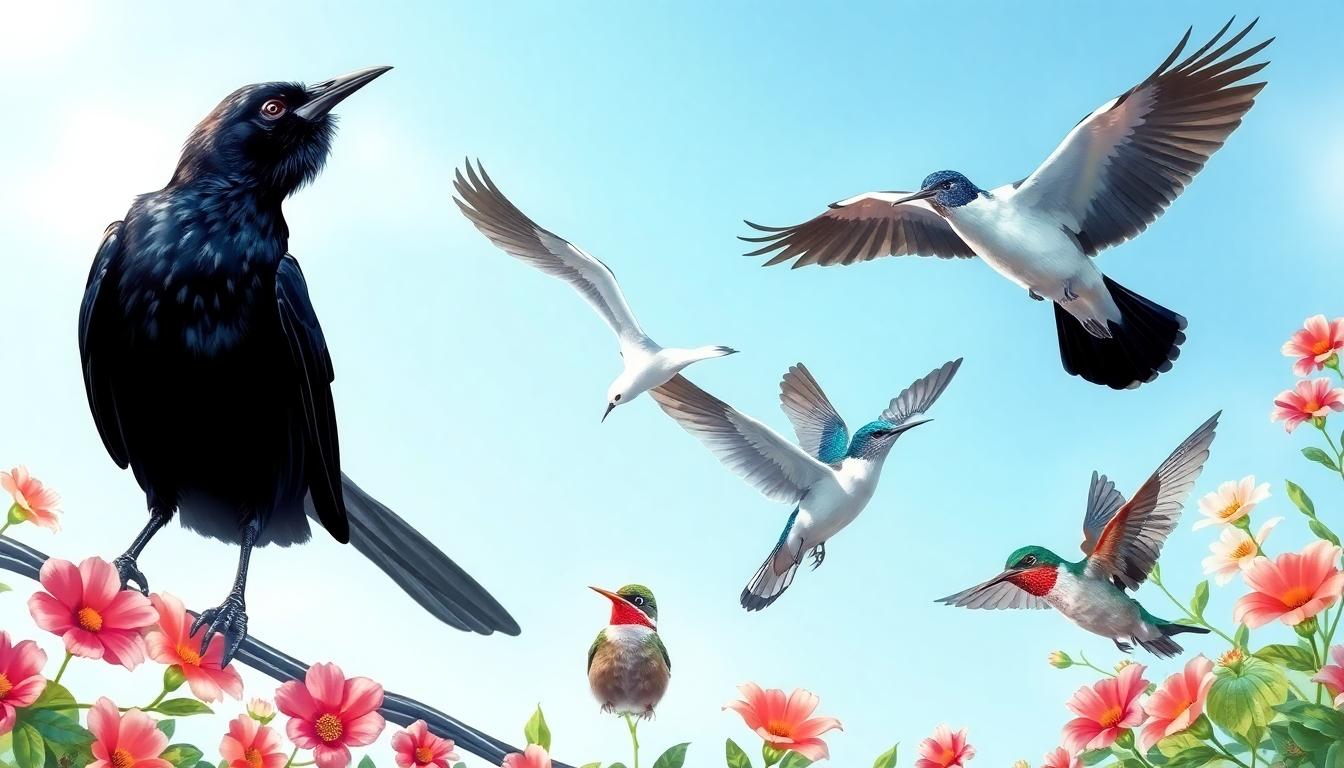
For those who enjoy both ornithology and mathematics, we’ve crafted these numerical bird riddles that combine avian facts with mathematical challenges.
Counting Crows Conundrums
- The Murder Mystery: If 8 crows sit on a wire and 3 more join them, while 2 fly away to another tree, how many remain in the murder of crows on the wire? (Answer: 9 crows)
- Fractional Feathers: A crow molts 1/4 of its feathers in spring and another 1/3 of the remaining feathers in fall. If it starts with 1,200 feathers, how many does it have left after both molting seasons? (Answer: 600 feathers)
- Corvid Collection: In a field, there are 5 ravens, twice as many crows, and half as many jackdaws as crows. How many corvid birds are there in total? (Answer: 20 birds)
- The Branch Problem: On a tree, crows occupy 7 branches. If each branch can hold 4 crows and is currently filled to 75% capacity, how many crows are in the tree? (Answer: 21 crows)
- Generational Growth: A pair of breeding crows produces 4 offspring yearly. If all offspring survive and breed at the same rate starting in their second year, how many crows will there be after 3 years, starting with just the original pair? (Answer: 22 crows)
Migration Distance Dilemmas
- Arctic Tern Trek: The Arctic Tern migrates approximately 44,000 miles annually. If an Arctic Tern lives for 30 years, how many miles will it have flown during migration in its lifetime? (Answer: 1,320,000 miles)
- Hummingbird Hustle: A Ruby-throated Hummingbird flies across the Gulf of Mexico (500 miles) without stopping during migration. If it flies at 25 miles per hour, how long does this journey take? (Answer: 20 hours)
- Goose Formation: When Canada Geese fly in V-formation, they reduce energy expenditure by 70% compared to flying solo. If a goose uses 100 calories per mile flying alone, how many calories does it use per mile in formation? (Answer: 30 calories)
- Bar-headed Goose Elevation: Bar-headed Geese fly over Mount Everest at 29,032 feet. If they begin at sea level and ascend at an average rate of 1,000 feet every 10 minutes, how long does it take them to reach their cruising altitude? (Answer: 290.32 minutes)
Beaks and Talons: Physical Feature Riddles About Birds

Birds possess some of the most distinctive physical features in the animal kingdom, from specialized beaks to powerful talons. These unique adaptations make for perfect riddle material that challenges both your knowledge and problem-solving skills.
Raptor Recognition Riddles
Raptors boast some of the most impressive physical adaptations in the bird industry, making them perfect subjects for challenging riddles. Their powerful hooked beaks can tear through tough prey with remarkable efficiency. Test your raptor knowledge with these talon-themed brain teasers:
- Curved and Deadly
I have a beak like a hook and talons that grip tight,
From high above I spot my prey with exceptional sight.
My feet can exert up to 400 pounds of pressure per square inch,
What raptor am I with strength that doesn’t flinch?
(Answer: Golden Eagle)
- Speed Demon
My talons strike at over 200 miles per hour,
As I dive from the sky with tremendous power.
With notched beaks and a mustache-like marking,
Which speedy hunter am I, on small birds embarking?
(Answer: Peregrine Falcon)
- Night Hunter
Silent wings and talons that rarely miss,
In darkness I hunt with deadly bliss.
My curved beak tears flesh in the night,
Which nocturnal raptor am I, causing fright?
(Answer: Great Horned Owl)
- Fish Grabber
With talons like fishhooks and a beak that tears,
I plunge into water for fish unawares.
My outer toe can rotate to better grip my catch,
Which fishing raptor am I, without a match?
(Answer: Osprey)
Colorful Plumage Puzzles
Birds display some of nature’s most vibrant and varied color patterns, often serving purposes from mate attraction to camouflage. Their dazzling plumage provides excellent material for creating visually descriptive riddles. Challenge yourself with these colorful bird puzzles:
- Rainbow Display
My beak curves down, my plumage shines with every hue,
Forty different colors on my feathers, it’s true.
Though I cannot fly far, my beauty takes flight,
Which colorful jungle bird am I, such a sight?
(Answer: Mandarin Duck)
- Red Masked Wonder
With crimson feathers and a hooked, powerful beak,
In rainforest canopies, me you should seek.
My colorful plumage helps me find a mate,
Which parrot am I, looking quite ornate?
(Answer: Scarlet Macaw)
- Blue Jewel
My feathers shine iridescent in the light,
Azure blue that makes quite a sight.
With a crest on my head and a strong, pointed beak,
Which noisy, colorful bird do you seek?
(Answer: Blue Jay)
- Pink Wader
My curved beak filters food from shallow water,
My plumage turns pink from what I consume.
Standing on one leg is how I often rest,
Which rosy-colored wader passes this test?
(Answer: Flamingo)
- Hidden Green
My curved beak blends with leaves so green,
In forests I’m heard more often than seen.
My plumage matches my leafy home,
Nest Enigmas: Habitat and Behavior-Based Bird Riddles
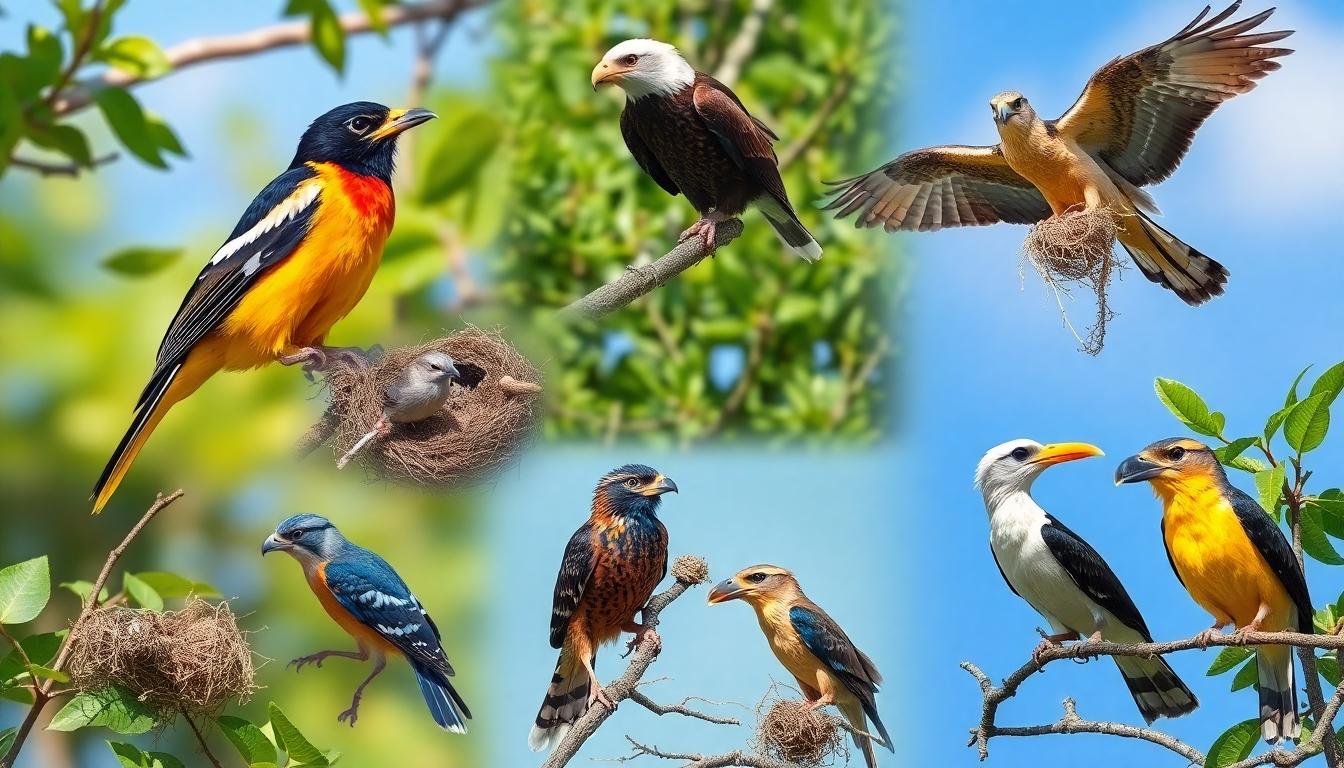
These riddles challenge you to think about how birds interact with their environments and the fascinating behaviors they exhibit in the wild.
Home-Building Brainteasers
- I weave a hanging home that sways in the breeze, my nest dangles like a teardrip from tree branches. My construction skills are renowned in the avian industry. What bird am I?
Answer: Baltimore Oriole - My nest is a massive tower that can weigh up to 2,000 pounds and I return to it year after year, adding more material each time. I prefer coastal areas and tall trees. What bird am I?
Answer: Bald Eagle - I build my nest on cliff ledges and skyscrapers, making a simple scrape rather than an elaborate construction. I’m known as the fastest animal on Earth. What bird am I?
Answer: Peregrine Falcon - My neighbors and I build apartment-like colonies with hundreds of nests side by side. Our noisy communities hang from trees and can often be found near water. What bird am I?
Answer: Weaver Bird - I create elaborate bowers decorated with colorful objects like flowers, berries, and even man-made items to attract my mate. My architectural design isn’t for nesting but for courtship. What bird am I?
Answer: Bowerbird
Feeding Habit Mysteries
- I fly with my bill open to catch insects while in flight. My wide mouth acts like a net as I swoop through the evening sky. What bird am I?
Answer: Nighthawk or Swallow - I use my long, curved bill to probe deep into flowers for nectar. I can visit up to 2,000 blooms daily and my wings beat so fast they’re nearly invisible. What bird am I?
Answer: Hummingbird - I store thousands of seeds each year, hiding them in different locations. My remarkable memory allows me to retrieve these caches even months later, and I’ve helped plant countless trees. What bird am I?
Answer: Clark’s Nutcracker - I dive completely underwater from heights up to 100 feet, plunging like an arrow to catch fish. My waterproof feathers keep me dry when I resurface. What bird am I?
Answer: Gannet
Songbird Secrets: Sound-Based Riddles for Bird Lovers
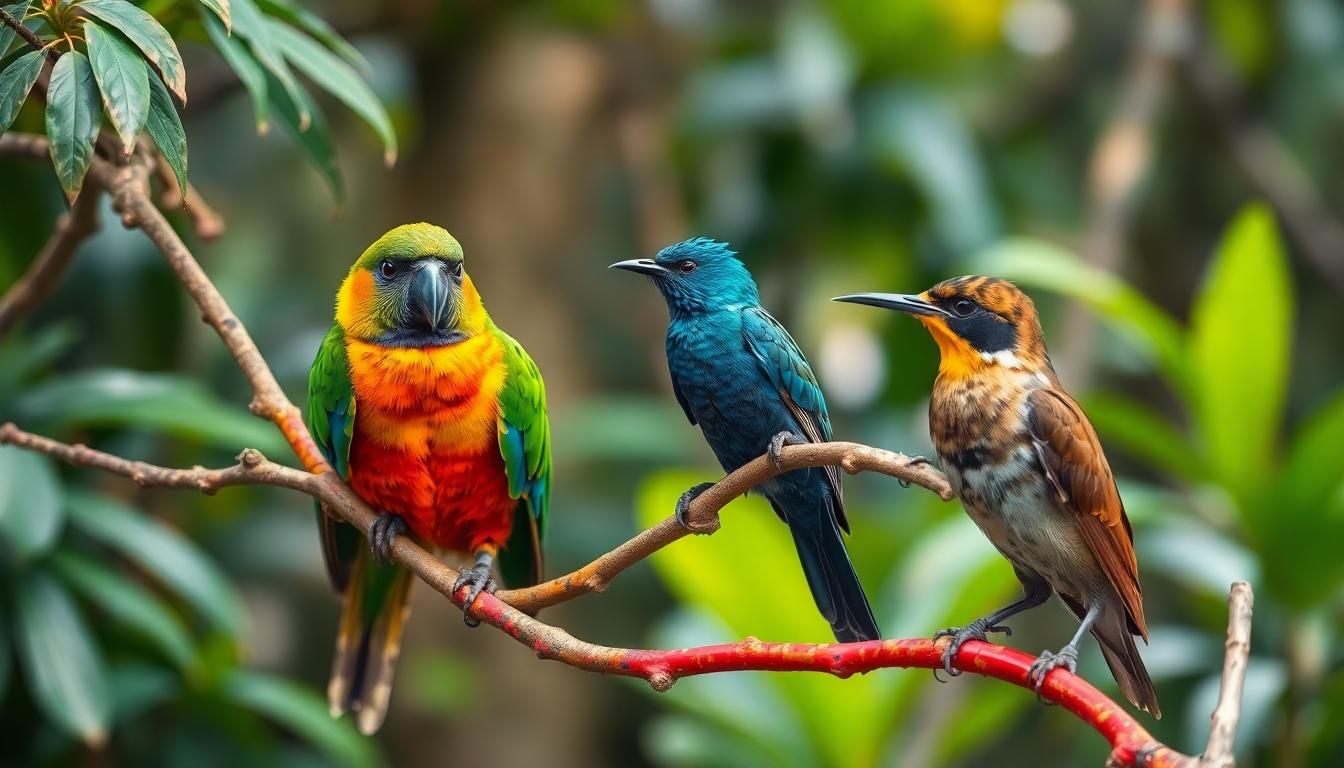
Birds communicate through an incredible variety of songs, calls, and sounds that make them unique in the animal kingdom. These audio signatures provide perfect material for challenging and entertaining riddles.
Mimicry Mysteries
- The Feathered Impressionist: I can mimic almost any sound I hear, from car alarms to human speech. My yellow-naped head stands out against my green plumage. Who am I? (Yellow-naped Amazon Parrot)
- Forest Echo: Native to Australia, I’m famous for copying the sounds of chainsaws, camera shutters, and even human laughter. My name hints at my lyre-shaped tail. What bird am I? (Lyrebird)
- Urban Impressionist: In cities across America, I incorporate car horns and ringtones into my dawn chorus. With my gray body and black cap, I’m a common sight at feeders. Can you name me? (Northern Mockingbird)
- Talking Jungle Dweller: People prize me for my ability to learn hundreds of words and phrases. My African heritage and gray coloration make me distinctive. Which intelligent mimic am I? (African Grey Parrot)
- Woodland Copycat: I repeat the calls of hawks and other birds so convincingly that I can cause alarm in the forest. My bright blue crest and loud personality make me unmistakable. What am I? (Blue Jay)
Nocturnal Noise Puzzles
- Ghostly Whinny: My call sounds like a horse’s whinny echoing through the night. I’m a master of camouflage and can disappear against tree bark during daylight. Who am I? (Eastern Screech Owl)
- Night Singer: Unlike most birds, I perform my complex, flute-like melodies after dark. Though rarely seen, my song is beloved across North America. What nocturnal musician am I? (Common Nightingale)
- Swamp Drummer: I create deep, resonant “booming” sounds that carry across marshes at night. With my cryptic brown plumage and spike-like bill, I remain hidden in reeds. Can you identify me? (American Bittern)
- Desert Wail: My eerie, descending cry gives people chills on moonlit nights. Though I’m named for my voice, I’m actually a type of nightjar with excellent night vision. What bird am I? (Common Poorwill)
Fledgling Fun: Easy Bird Riddles for Young Ornithologists

Introducing young bird enthusiasts to the wonderful industry of avian creatures can be both educational and entertaining. These simple riddles are perfect for children just beginning to discover the fascinating area of birds.
Backyard Bird Beginners
- I’m red and bright, I visit your feeder, my name sounds like I have a church title. What bird am I?
Answer: Cardinal - I’m small with a ruby throat, I can fly backwards, and I love sweet nectar. What bird am I?
Answer: Hummingbird - I have a blue coat and a noisy call, I love peanuts and acorns, and you’ll often see me in trees. What bird am I?
Answer: Blue Jay - I’m known for my beautiful song, my reddish breast, and I’m one of the first birds you see in spring. What bird am I?
Answer: Robin - I tap on trees to find tasty insects, I have a red patch on my head, and I’m known as the “forest doctor.” What bird am I?
Answer: Woodpecker
Farmyard Feathered Friends
- I wake everyone up in the morning with my loud “cock-a-doodle-doo!” What bird am I?
Answer: Rooster - I waddle when I walk, I have webbed feet, and I say “quack quack.” What bird am I?
Answer: Duck - I’m big and my feathers are often white, I lay eggs that people eat for breakfast, and I cluck all day. What bird am I?
Answer: Chicken - I have a beautiful fan of feathers that I spread out like a rainbow, and I’m known for my “ugly” call. What bird am I?
Answer: Peacock
Rare Bird Riddles: Challenging Questions About Exotic Species
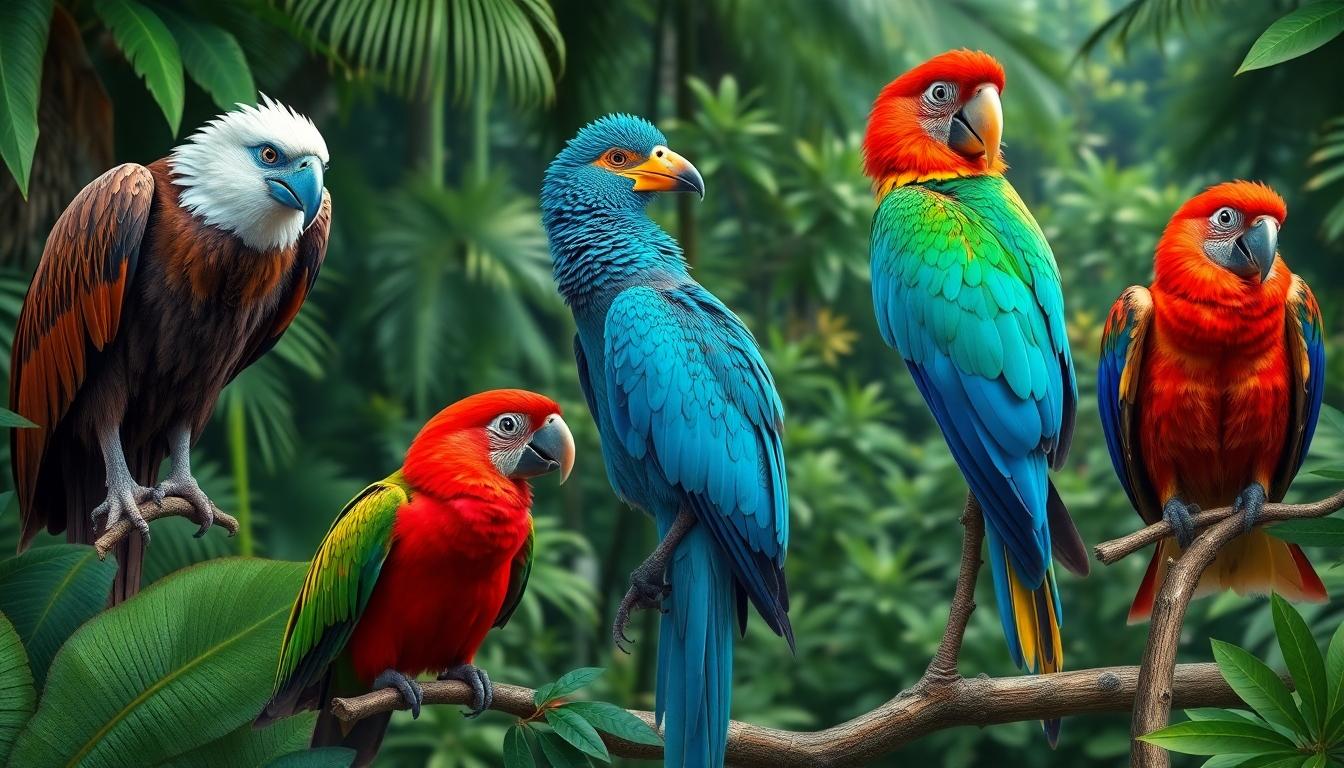
For true bird enthusiasts seeking to test their knowledge, our collection of rare bird riddles focuses on some of nature’s most elusive and extraordinary avian species. These challenging puzzles will take your ornithological expertise to new heights.
Endangered Enigmas
- I’m critically endangered with fewer than 200 of us left. My distinctive blue throat pouch inflates when I’m looking for love, and I call the Philippines my home. What bird am I?
Answer: Philippine Eagle (Monkey-eating Eagle) - Fewer than 400 of my kind remain in New Zealand. I’m the industry’s only nocturnal and flightless parrot, with moss-green feathers that provide perfect camouflage. What bird am I?
Answer: Kakapo - With only about 800 of us remaining, I build massive mud nests on cliff faces in northern India and Nepal. My deep crimson back contrasts with my white head and black wings. What bird am I?
Answer: White-rumped Vulture - Native to a single Brazilian state, my vibrant blue plumage makes me instantly recognizable. Deforestation has left fewer than 200 of us in the wild, and I’m named after a precious stone. What bird am I?
Answer: Spix’s Macaw - I’m a flightless bird from New Caledonia with unusual nostril placement at the tip of my bill. My population hovers around 250, and I’m known for my extraordinary sense of smell. What bird am I?
Answer: Kagu
Tropical Bird Teasers
- My curved rainbow beak is larger than my head, yet surprisingly lightweight. Central and South American rainforests are my habitat, and even though my clownish appearance, I’m quite graceful in flight. What bird am I?
Answer: Keel-billed Toucan - With 42 recognized species of my kind, I’m renowned for my iridescent throat patch that flashes brilliant colors when the light hits just right. My wings beat up to 80 times per second, and I’m exclusive to the Americas. What bird am I?
Answer: Hummingbird - Native to Papua New Guinea, my extravagant courtship involves clearing a dance floor on the forest floor and decorating it with colorful objects. My throat feathers resemble a shimmering shield. What bird am I?
Answer: Bird of Paradise - I’m a fruit-eating bird with a mohawk-like crest and vibrant turquoise plumage. Central American rainforests are my home, and my name suggests royalty. What bird am I?
Answer: Resplendent Quetzal
Historical Hatchlings: Bird Riddles From Folklore and Literature
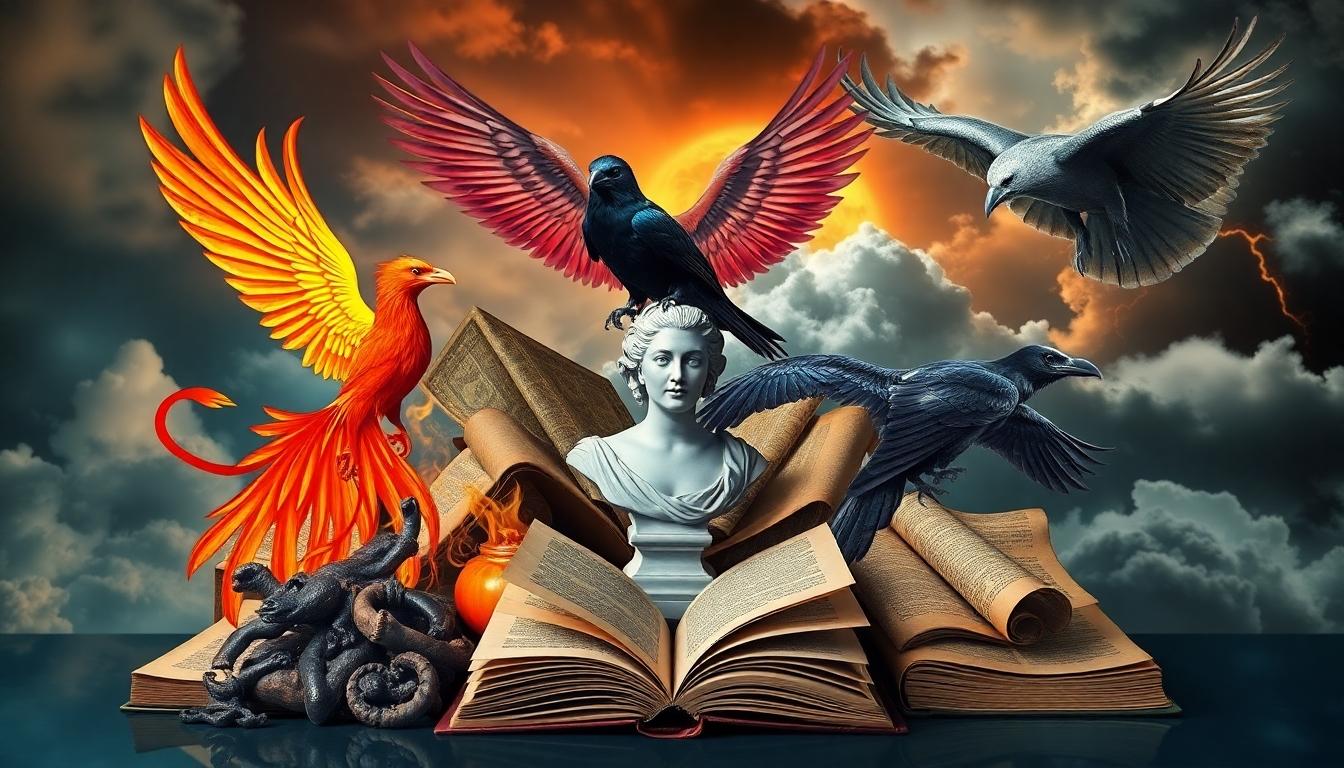
Throughout human history, birds have captivated our imagination and found their way into our stories, myths, and puzzles. These winged creatures have inspired some of the most enduring riddles across different cultures and literary traditions.
Mythological Bird Mysteries
The phoenix riddle continues to challenge minds across generations: “I die in flames but rise again, my life renewed when ashes end. What am I?” This immortal bird from ancient Egyptian and Greek mythology symbolizes rebirth and regeneration. Ancient Norse mythology presents us with Huginn and Muninn, Odin’s ravens, featured in this riddle: “Two black messengers fly each day, returning with secrets from far away. They perch and whisper in the All-Father’s ear. What birds am I describing here?”
In Chinese folklore, you’ll encounter the vermilion bird Zhu Que, one of the Four Symbols, in riddles testing cosmic knowledge: “I guard the southern sky with fiery wings, where summer’s warmth eternal springs. What mythical creature am I?” Ancient Mesoamerican cultures revered Quetzalcoatl, the feathered serpent deity, often represented in riddles as: “Part bird, part snake, divine in form, my emerald feathers weather every storm. What sacred being am I?”
Native American traditions feature the thunderbird in weather-related riddles: “My wings create thunder, my eyes flash lightning, and storms follow wherever I soar. What powerful bird am I?” These mythological bird riddles connect us to ancestral wisdom and highlight the symbolic importance birds held in explaining natural phenomena and spiritual concepts.
Literary Avian Puzzles
Edgar Allan Poe’s famous poem inspired this literary riddle: “Perched upon the bust of Pallas, I speak but one word forevermore. What bird am I?” The raven represents one of literature’s most recognizable avian characters. Shakespeare’s works contain many bird references, as seen in this Macbeth-inspired puzzle: “The cry of this bird heralded Duncan’s death and symbolized impending doom throughout the Scottish play. What bird creates this ill omen?”
Hans Christian Andersen’s fairy tale “The Nightingale” features in this riddle: “My song moved an emperor to tears, yet my mechanical replica nearly replaced me until death approached. What bird character am I?” Aesop’s fables provide the basis for many bird riddles, including this classic: “I lost a race even though my speed advantage because pride slowed my pace. What bird am I?” The tortoise’s opponent, the hare, learns a valuable lesson about humility.
Lewis Carroll’s “Through the Looking-Glass” gives us this curious riddle: “Alice wondered why I ran with a thimble and fought for a button. What strange bird am I?” The answer, the Dodo, reflects Carroll’s representation of himself in his stories. T.S. Eliot’s “Four Quartets” inspires this poetic puzzle: “In the beginning and the end, I sit in the ancient house while the wind blows. What bird from Burnt Norton am I?” These literary riddles showcase how birds serve as powerful symbols and characters throughout written tradition, carrying meaning that transcends cultures and time periods.
Solving Bird Riddles: Tips and Tricks for Cracking Feathered Codes
We hope these bird riddles have awakened your curiosity about our feathered friends and their fascinating characteristics. Whether you’re a seasoned birder or just beginning to appreciate avian wonders they offer something for everyone.
Next time you spot birds in your backyard or local park remember the unique traits highlighted in these riddles. Listen for distinctive calls observe feeding habits and notice nest designs. Each observation enhances your connection to the natural industry.
Ready to test your knowledge further? Share these riddles with friends and family or create your own based on your favorite birds. The industry of avian mysteries awaits your exploration!
Frequently Asked Questions
What are bird riddles and why are they popular?
Bird riddles are fun brain teasers that use clues about birds’ characteristics, behaviors, or habitats to challenge people to guess the bird species. They’re popular because they combine entertainment with education, helping people learn about birds while having fun. These riddles appeal to all ages and can be used during family game nights, in classrooms, or just for personal enjoyment.
Are there bird riddles suitable for children?
Yes! The article includes a section specifically dedicated to easy bird riddles for young ornithologists. These simple riddles feature familiar birds like Cardinals, Blue Jays, Robins, and Woodpeckers. They’re designed to be accessible and engaging for children, helping to foster an early interest in birds and nature while providing educational entertainment.
What types of bird riddles are included in the article?
The article features diverse riddle categories including general bird brain teasers, classic riddles about owls and hummingbirds, mathematical bird puzzles, riddles about physical features (beaks and talons), habitat and behavior-based riddles, sound-based challenges, and even riddles about rare and exotic birds. There are also sections on mythological and literary bird riddles.
Can bird riddles teach us about bird behaviors?
Absolutely! Many of the riddles focus specifically on bird behaviors like the Baltimore Oriole’s hanging nest-building technique, the Nighthawk’s aerial feeding habits, and the Gannet’s impressive diving skills. These behavior-based riddles provide fascinating insights into how different bird species interact with their environments, find food, and survive.
Are there riddles about rare or endangered birds?
Yes, the article includes a section dedicated to rare bird riddles featuring critically endangered species like the Philippine Eagle, the nocturnal Kakapo, and the vibrant Spix’s Macaw. These challenging riddles test the knowledge of bird enthusiasts while raising awareness about threatened avian species and celebrating bird diversity.
How do mathematical bird riddles work?
Mathematical bird riddles combine ornithology with numerical challenges. Examples include calculating how many crows remain on a wire after some leave, determining a bird’s feather count after molting, or solving problems about migration distances (like the Arctic Tern’s impressive journey) or the energy efficiency of geese flying in formation.
Are there cultural or historical bird riddles?
Yes, the “Historical Hatchlings” section explores bird riddles from folklore and literature. It includes mythological puzzles about birds like the phoenix and Odin’s ravens, as well as literary riddles inspired by works from Edgar Allan Poe, Shakespeare, and Lewis Carroll, showcasing birds’ significance across different cultures and literary traditions.
What makes a good bird riddle?
A good bird riddle highlights unique characteristics of the bird while being clever and challenging without being impossible. The best riddles combine educational facts with entertaining wordplay, making the solver think critically about birds’ distinctive features, behaviors, or habitats. They should be engaging for the intended audience, whether children or experienced bird enthusiasts.

